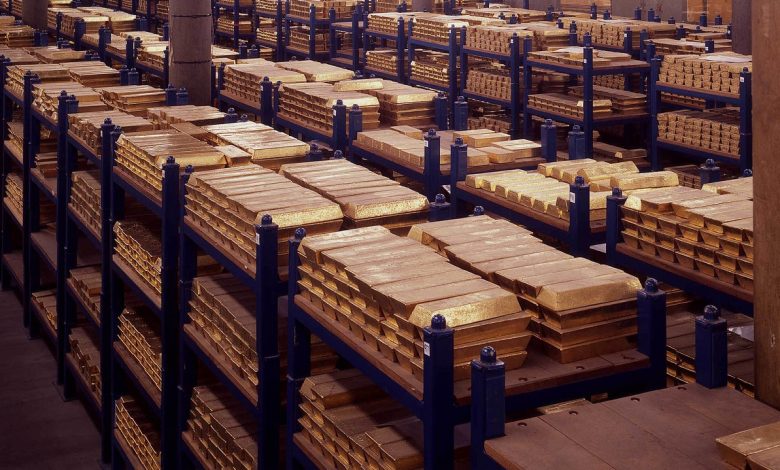Central Bank Gold Buying Continued Unabated in September

Central banks continued to gobble up gold.
Reported central bank gold reserves expanded by a net 77 tons in September with nine countries buying a ton or more.
With September’s purchases, central banks added a net 337 tons of gold in Q3. It was the second-highest third-quarter total on record behind 2022.
China continued to be the biggest gold purchaser, adding another 26 tons of gold to its hoard in September. It was the 11th straight month of increasing Chinese gold reserves.
Since the beginning of the year, the People’s Bank of China has increased its reserves by 181 tons, and it has added 232 tons since it resumed official purchases in November 2022. As of the end of September, China officially held 2,192 tons of gold, making up 4% of its total reserves.
And the country likely has more gold than that.
There has always been speculation that China holds far more gold than it officially reveals. As Jim Rickards pointed out on Mises Daily back in 2015, many people speculate that China keeps several thousand tons of gold “off the books” in a separate entity called the State Administration for Foreign Exchange (SAFE).
Last year, there were large unreported increases in central bank gold holdings. Central banks that often fail to report purchases include China and Russia. Many analysts believe China is the mystery buyer stockpiling gold to minimize exposure to the dollar.
Poland was another big gold buyer in September, adding 19 tons to its reserves.
Year-to-date, the National Bank of Poland has bought 105 tons of gold, in line with a plan to add 100 tons to its reserves Bank of Poland President Adam Glapiński announced in 2021.
Glapiński recently indicated the buying will likely continue.
This makes Poland a more credible country, we have a better standing in all ratings, we are a very serious partner and we will continue to buy gold. The dream is to reach 20 percent.”
When he announced the plan to expand its gold reserves, Glapiński said holding gold was a matter of financial security and stability.
Gold will retain its value even when someone cuts off the power to the global financial system, destroying traditional assets based on electronic accounting records. Of course, we do not assume that this will happen. But as the saying goes – forewarned is always insured. And the central bank is required to be prepared for even the most unfavorable circumstances. That is why we see a special place for gold in our foreign exchange management process.”
Turkey added 8 tons of gold to its holdings in September and appears to be back on the path toward expanding its reserves.
The Turkish central bank sold 160 tons of gold last spring but returned to buying in the third quarter. According to the World Gold Council, the big gold sale earlier this year was a specific response to local market dynamics and didn’t likely reflect a change in the Turkish central bank’s long-term gold strategy. It sold gold into the local market to satisfy demand after the government imposed import quotas in an attempt to improve its current account balance. The country is running a significant trade deficit.
Although the Turkish government reinstated gold import quotas in early August, so far we haven’t seen a repeat of sales into the local market to meet elevated demand.
India purchased 7 tons of gold in September. It purchased small amounts of gold over the previous four months, but this was the biggest buy by the Reserve Bank of India since July 2022.
Since resuming buying in late 2017, the Reserve Bank of India has purchased over 200 tons of gold. In August 2020, there were reports that the RBI was considering significantly raising its gold reserves.
The other buyers in September include:
- Uzbekistan – 9 tons
- Czech Republic – 2 tons
- Qatar – 2 tons
- Singapore – 1 ton
- Kyrgyz Republic 3 tons
The only notable sale was by Kazakhstan. Its central bank decreased reserves by 1 ton.
It is not uncommon for banks that buy from domestic production – such as Uzbekistan and Kazakhstan – to switch between buying and selling.
The World Gold Council said it’s “all but certain that central banks are on course for another colossal year of buying,” after a record-setting 2022.
The strength of buying has, to some degree, exceeded our expectations. While we were confident that central banks would remain net purchasers in 2022, we thought it unlikely that it would match last year’s record buying volume. Should buying continue to be strong in Q4, the full-year total could get closer than we anticipated. Nevertheless, the historically high level of buying in Q4 2022 may be difficult to top.”
Total central bank gold buying in 2022 came in at 1,136 tons. It was the highest level of net purchases on record dating back to 1950, including since the suspension of dollar convertibility into gold in 1971. It was the 13th straight year of net central bank gold purchases.
According to the 2023 Central Bank Gold Reserve Survey recently released by the World Gold Council, 24% of central banks plan to add more gold to their reserves in the next 12 months. Seventy-one percent of central banks surveyed believe the overall level of global reserves will increase in the next 12 months. That was a 10-point increase over last year.
Call 1-888-GOLD-160 and speak with a Precious Metals Specialist today!
Buka akaun dagangan patuh syariah anda di Weltrade.
Source link






